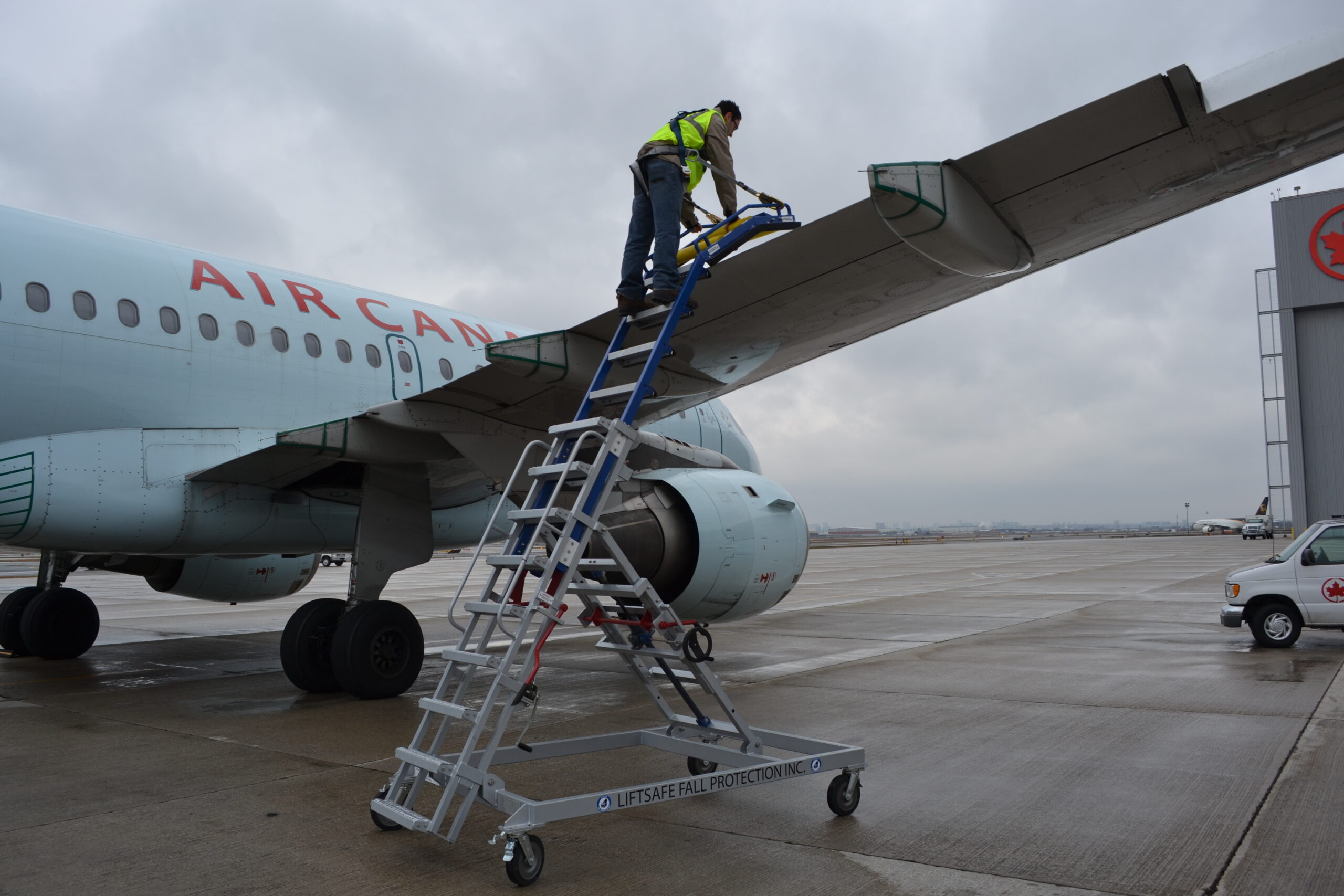Related: Aircraft Maintenance Stand, Aviation Platform Stand & Engine Access Stand
Revised March 2020
When reviewing job sites, working safely at heights is at the forefront for regulators and inspectors. Recognizing that even relatively small falls can result in devastating injuries, lost production and large fines, employers are more likely than ever to look for different options of fall protection to keep workers safe. Too often however, employers set oversimplified goals intended to meet the letter of the law rather than creating a safe solution for their specific requirements.
Providing safety for workers at heights usually begins with evaluating the applicable legislation – this is when the “ do we need fall protection” question arises. Typically the default height is given by federal (OSHA) or regional regulations which are cited as the rule, when in fact they are only a starting point or a minimum requirement. If the only target is to be “tied off above 6 feet,” the employer is missing the point. They are aiming for “compliance” rather than “safety,” and workers may not be receiving all the protection they need.
A safety-based approach looks beyond the minimum requirements to see what is truly “safe.” Just because OSHA states that fall protection is required above 6 feet, does not mean that a fall from 5 feet is perfectly safe.
Risk of Injury
Anyone who has ever slipped on an icy sidewalk can verify that there is indeed a risk of injury, even at height “zero.” As workers get higher above grade, the energy involved in a fall increases, as does the potential for more serious injury. When there are any additional risks, more stringent requirements need to be considered.
When evaluating any elevated work environment, the minimum height for fall protection must be considered, but for work situations near or even below that height, there are often many opportunities to work safer. With toolboxes, equipment, or other hazards near where a worker may fall, there is an increased risk of injury, even for a short fall.
A proper assessment is required to determine what risks are present for the employee during a given task, including getting to or from the work area.
Once the risks are more fully understood, a more organized approach to finding solutions can be employed.
The standard hierarchy of solutions is based on keeping things as simple as possible:
- Review of the process – is there another way to do the task?
- The barrier between hazard/worker
- Active travel restraint/restriction system
- Active fall arrest system
Review the Maintenance Process
Too often, tasks are completed the way they have always been done. Taking a couple minutes to see if a given task could be performed in a different way that does not involve being at height is the first step. Remote technologies now enable maintenance workers to complete tasks remotely. From light-bulb changing baskets on a painters’ pole to using chains for overhead valves, new innovations are constantly being developed to help make tasks easier, quicker and safer. More recently, small remote-controlled drones are being used with cameras to allow inspections of hard to see or access areas while workers are safely on the ground. Based on this initial inspection it can be determined if more time-consuming hands-on work is required.
Compliance–based objectives seek only to examine if fall protection is needed for a certain job, whereas a safety-based approach looks to see if a task can be executed in a safer, easier and faster way.
Reviewing the job process at regular intervals allows one to observe if there are any new technologies or approaches available to simplify the process.
What is the Simplest Solution?
If the work must be completed with a worker at heights, the next simplest solution is to provide a safe work area with a fixed barrier between the worker and any potential hazard. This could be a fixed or mobile work platform with guardrails to prevent the worker from accidentally falling from the work platform.
The use of a stable work platform with guardrails provides the worker with the simplest solution for working at heights, effectively simulating on-the-ground conditions. Many situations however, utilize a mobile platform, but then require a worker to lean out, or climb up on the rails to reach the work area. Often the use of an approved platform is confused with using the appropriate tool for the job. A safety-based approach starts with getting the worker to where they need to be and choosing the right approach from there, rather than taking a good tool and using it for every application.
Fall Arrest vs. Fall Restraint Systems
When the work is located in an area where a flat, stable platform is not possible, the next step is to provide a system that will get the worker to the area, but prevent them from falling by incorporating an active restraint system. Custom access ladders or some horizontal lifeline systems can be set up so workers can reach their work without falling. In addition, working from a custom ladder, the worker has a restraint system to keep them from falling.
Use of pre-engineered lifeline kits can be used to solve specific problems, but with caution, as it is unsafe to apply one solution to multiple scenarios, as it may not always be suitable. For instance, a restraint lifeline may work well along with the wings of a large aircraft, but on a smaller plane, the same system and lanyard would permit the worker to fall.
As we move from a barrier to a restraint system, the worker has greater responsibility to ensure they are wearing the harness and actively secure the system. The system must be set up so that when working, the range of motion does not allow the worker to ever be in a situation where a fall is possible. This ability to fall is the critical distinction between fall arrest and fall restraint – despite the two terms being commonly interchanged.
In cases where workers must be at heights, and need the freedom to move around with the potential to fall, a fall arrest system is employed. Fall arrest systems are far more complex as they must consider a worker’s free-fall distance, clearance, energy and more. These systems require the most input from end-users, as they must not only be designed, inspected and operated properly, but the subsequent rescue is a mandatory requirement for use of a fall arrest system. If a worker can fall, there must be a way to safely get them to the ground.
Fall arrest systems alone are a broad enough topic for discussion, but from a safety perspective, fall arrest must not be fully designed (taking into account the end location of a fallen worker) but be paired with rescue, as having one without the other is often a symptom of simply trying to meet a compliance target.
Too often, the task of overhauling the working-at-heights process within the workplace is a highly intensive, time-consuming process, and the appeal of simplifying it all is tempting. Unfortunately, this can lead to situations where workers may still not have the right tools for the job or are working in unsafe conditions despite attempts to meet a compliance target. A safety-based approach is admittedly more time-consuming, and involves evaluating each task, but has the more enviable target, which is to ensure the job is being done safely.
To view the full article in AMT Magazine, click here.
Brad Lawrence, P.Eng., is a Senior Engineer (Fall Protection and Safety Audits) of Liftsafe Group of Companies. He has been a critical member of the company since 2007 and manages the Fall Protection Division at Liftsafe Fall Protection Inc. As an active participant on the CSA Standards Committee for Fall Protection Solutions, he utilizes his extensive experience to assist in developing fall protection standards throughout Ontario. For more information visit www.fallsafetysolutions.com.


